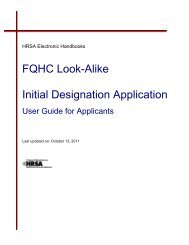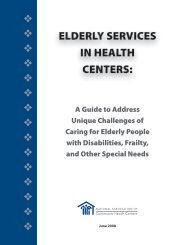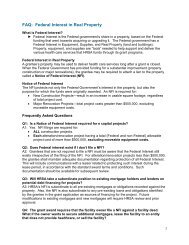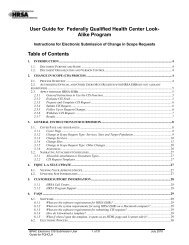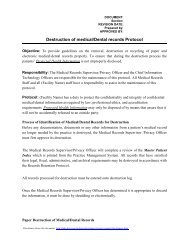Capital Development Notice of Grant Award Frequently ... - HRSA
Capital Development Notice of Grant Award Frequently ... - HRSA
Capital Development Notice of Grant Award Frequently ... - HRSA
Create successful ePaper yourself
Turn your PDF publications into a flip-book with our unique Google optimized e-Paper software.
CD NGA <strong>Frequently</strong> Asked Questionsmortgages, selling the facility, or leasing the facility to an entity that does not provide healthcare, requiresprior approval from the <strong>HRSA</strong>. The NFI will not affect existing mortgages or modifications being made tothe facility.Prior approval must come in the form <strong>of</strong> a written request from the grantee to <strong>HRSA</strong>, either by letter or byemail, with the following information:1. What is the action that the owner wants to undertake (new loan, refinancing, expansion, sale,etc.)?2. What is the grantee or owner requesting from <strong>HRSA</strong> (permission to secure a new loan, transfer toanother site, etc.)?3. If applicable, details <strong>of</strong> the project financing (the combination <strong>of</strong> loans and internal funding), orproposed sale (whether there is an identified buyer, the proposed sale price).4. Copy(s) <strong>of</strong> all <strong>HRSA</strong> NFIs, associated <strong>Notice</strong>(s) <strong>of</strong> <strong>Grant</strong> <strong>Award</strong>, and/or funding informationassociated with the NFI. A copy <strong>of</strong> the deed, with a legal description <strong>of</strong> the property, to which theFederal Interest is attached.5. Appraised value <strong>of</strong> the property at the time <strong>of</strong> project completion.6. Terms <strong>of</strong> the proposed loan, i.e., interest rate, period <strong>of</strong> loan, amortization schedule.7. Last three years <strong>of</strong> audited Financial Statements.Reviewing Federal Interest requests takes time and <strong>HRSA</strong> requests patience and cooperation in theprocess. Providing detailed requests and supporting documentation up front will aid in expeditingreviews.24. Will the value <strong>of</strong> the Federal Interest change over time, especially as the useful life <strong>of</strong> therenovation/alteration expires?Each alteration/renovation project having a total (Federal and non-Federal) allowable project costs <strong>of</strong>more than $500,000, excluding moveable equipment costs, is required to file a NFI.<strong>HRSA</strong> acknowledges that the market value <strong>of</strong> <strong>HRSA</strong>-supported renovations/alterations will change overtime. <strong>HRSA</strong> will work with grantees to recognize the changing market value <strong>of</strong> improvements and otheractivities made by the grantee or property owner <strong>of</strong> the facility.ENVIRONMENTAL AND HISTORIC PRESERVATION REQUIREMENTS25. What is the National Environmental Policy Act?The National Environmental Policy Act (NEPA) requires every Federal agency to follow a specificplanning process to ensure that agency decision-makers and applicants have considered and the generalpublic is fully informed about, with the opportunity to comment on, the environmental consequences <strong>of</strong> aFederally funded action. This review and consultation process is used to evaluate the impact a projectand its alternatives may have on the environment. The review process required by NEPA is usually thevehicle through which <strong>HRSA</strong> addresses other environmental laws and regulations.It should be noted that compliance with other individual laws such as Floodplain Management, Wetlands,the National Historic Preservation Act, Endangered Species Act, the Comprehensive EnvironmentalResponse and Liability Act, among other Federal, State, and locally required laws, may still be required.26. What is the National Historic Preservation Act?The National Historic Preservation Act (NHPA) requires Federal agencies to take into account the effects<strong>of</strong> their undertakings on historic properties. Federal agencies must consult with parties who have aninterest in the effects <strong>of</strong> the undertaking in order to identify the affected historic properties, assess theeffect <strong>of</strong> the undertaking on historic properties, and seek ways to avoid, minimize, or treat any adverseeffects on historic properties.Page 5
CD NGA <strong>Frequently</strong> Asked Questions<strong>HRSA</strong> complies with NHPA and its implementing regulations in 36 CFR Part 800, by following standardregulatory procedures, commonly referred to as the Section 106 Process. Historic properties includedistricts, buildings, structures, objects, landscapes, archaeological sites, and traditional cultural propertiesthat are included in, or eligible for inclusion in, the National Register <strong>of</strong> Historic Places. These propertiesare not just old buildings or well-known historic sites, but places important in local, State, or nationalhistory. The National Register <strong>of</strong> Historic Places is a list <strong>of</strong> recognized historic properties. However, thislist is not complete, and States may have additional properties with historic significance.27. Do all construction and renovation projects require preparation <strong>of</strong> a draft EnvironmentalAssessment or Section 106?No. Some construction and renovation projects may fall under a Programmatic EnvironmentalAssessment prepared by <strong>HRSA</strong>. The NGA should identify the environmental and historic preservationrequirements needed to satisfy the condition <strong>of</strong> award. In some cases, the information submitted with theapplication may not have been sufficient to determine the level <strong>of</strong> compliance, and additional informationmay be requested.28. Do environmental and historic preservation requirements just apply to portions <strong>of</strong> my projectbeing funded with the Federal grant?No. It is important to note that the environmental and historic preservation compliance requirementsapply to the total scope <strong>of</strong> the project, including non-Federally funded connected actions. Also be awarethe future changes in the scope <strong>of</strong> project (such as a new site, or adding parcels, or changing theconfiguration <strong>of</strong> the facility) may necessitate reinstatement <strong>of</strong> environmental and historic preservationconditions.29. Can I start site or construction work on my project even though I haven't completed myenvironmental or historic preservation conditions yet?The <strong>Notice</strong> <strong>of</strong> <strong>Grant</strong> <strong>Award</strong> clearly states that only non-construction preparatory activities such asarchitectural and engineering designs, permitting, licenses, and work related to the environmental andhistoric preservation reviews may be undertaken prior to the release <strong>of</strong> the environmental or historicpreservation conditions. Use <strong>of</strong> grant funding to complete these activities is allowable.At the time an award is made, grantees that proceed to undertake site preparation, construction, andrenovation work without meeting the appropriate conditions do so at their own risk. If subsequentenvironmental or historic preservation reviews indicate site conditions or impacts that cannot beappropriately addressed or mitigated, <strong>HRSA</strong> may be unable to fund the project.30. My NGA states that I need to consult with my Project Officer regarding CD requirements.When will my PO let me know?CD applications have already undergone technical reviews. Contact the C8A Project Officer regardingthis deliverable.31. Is the draft EA project-specific? Since we are proposing alterations to a 10,000 square footunit within a large existing facility, would an EA that was done earlier in 2009 be sufficient orwould we need to do an EA on our proposed remodel <strong>of</strong> the interior space for use as a healthcenter?EA’s are project specific. Some grantees that proposed alteration/renovation projects received acondition on their award informing them if a draft EA is required or if they should consult with the assignedC8A Project Officer to determine if one is required. If it is required, the draft EA must be specific to theproposed CD project. However, general information from the previous EA could serve as a base andprovide much <strong>of</strong> the information that is required in the draft EA for <strong>HRSA</strong>. Additional technical assistanceon the requirements <strong>of</strong> the draft EA can be found at http://bphc.hrsa.gov/capital.32. One <strong>of</strong> the CD grant conditions for our construction project requires us to submit draft EAwithin 90 days <strong>of</strong> award issue date. We do not think we will be able to meet this deadline.The EA guidance on the CD website indicates that the EA must be submitted prior to drawingdown construction funds but that architectural funds may be drawn down prior to submittingPage 6
CD NGA <strong>Frequently</strong> Asked Questionsthe EA. Is it permissible for me to miss the 90 day deadline and submit the EA prior todrawing down construction funds?<strong>Grant</strong>ees should submit the draft EA, if required, as soon as possible. If grantees are not able to meet thedeadline (90 days after award), send an email to the C8A Project Officer identified on the NGA with arequest to extend the deadline and an explanation as to why the extension is necessary. <strong>Grant</strong>ees mayNOT begin the construction project until the draft EA has been approved by <strong>HRSA</strong>.CHANGE IN SCOPE—SITES33. UPDATED In our CD application, we proposed moving the clinic to a larger space. I thoughtthe CD application instructions stated that this would be the Change in Scope request andthat we did not have to submit a change per PIN 2008-01. Do we have to submit a change inscope request?If the Form 5B and the Add Site Checklist for the new site was completed within the CD application,grantees do not need to take any further action. <strong>HRSA</strong> has reviewed new site requests and the NGA willindicate whether the site has been approved. If there are any terms/conditions listed in the NGA relatedto the Change in Scope, please contact the assigned C8A Project Officer to discuss.34. If a project involving a new site is among the projects funded within the CD NGA, can weassume that it has been <strong>of</strong>ficially approved to be added to our scope <strong>of</strong> Federal project?The CD NGA contains a term that approves the site address proposed in the CD application. This sitewill be added to the grantee’s list <strong>of</strong> sites that are “Pending Verification” and the grantee will need to verifythe new site is operational within 60 days <strong>of</strong> becoming operational at that site.CHANGE OF SCOPE OF WORK—CD GRANT35. What happens if we find we want to change our original CD project?CD projects must be implemented as they were proposed in the application since the CD is a competitivefunding opportunity. <strong>HRSA</strong> may take action to withdraw the approval and funds for the project(s) ifsubsequent events lead <strong>HRSA</strong> to conclude that a project as originally proposed is ineligible or cannot becompleted. Subsequent events could include, but are not limited to:(1) The identification or previously undocumented environmental or historic preservation issues thatlead <strong>HRSA</strong> to conclude a construction project cannot be carried out;(2) The conclusion that the project cannot be completed as proposed (e.g., information submittedthrough the required reporting indicates that the grantee’s progress is sufficiently noncompliantwith the approved scope, costs, or timeline presented in the application and that completion asproposed will not be possible); or(3) The conclusion that the grantee is noncompliant with a requirement <strong>of</strong> the application guidance(e.g., the CD project is not separate and distinct from a CIP project; grantee does not resolveconcerns to the satisfaction <strong>of</strong> <strong>HRSA</strong>).36. We are not able to secure the additional financing for the project we proposed. We would liketo either scale back our renovations or use the CD funds to purchase equipment. Can we dothis?No. <strong>Grant</strong>ees will not be able to significantly scale back projects or use CD funds to purchase equipment.Due to the competitive nature <strong>of</strong> this funding opportunity, no changes can be made given the project(s)were assessed and ranked against the review criteria established in <strong>HRSA</strong>-10-029.37. What if we are not able to complete the construction project as originally proposed, due tounforeseen circumstances beyond our control? What can we do?Depending on the nature <strong>of</strong> the circumstances (i.e., natural disaster), grantees may—on a case-by-casebasis ONLY—be able to scale back projects, modify the scope <strong>of</strong> the project, or use CD funds toPage 7
CD NGA <strong>Frequently</strong> Asked Questionspurchase equipment. No significant changes can be made to CD projects. <strong>Grant</strong>ees must contact theC8A Project Officer immediately to discuss options.ADMINISTRATIVE AND POLICY REQUIREMENTS38. UPDATED What needs to be recorded if the grantee does some work through its facilitiesmanagement staff (“force account labor”) and where does information need to be sent?<strong>HRSA</strong> needs a basic level <strong>of</strong> information in order to approve the work. A simple cost analysis thatdescribes the amount the organization spent for its own labor and materials, and how this approach iscost effective given the amount a contractor would charge to do the equivalent work, is sufficient. Anysupporting documentation should be sent to the assigned C8A Project Officer. For purposes <strong>of</strong> trackinggrant expenditures, please remember to track hours spent supporting all CD activities on employeepayroll records.39. Is my project subject to the simplified acquisition threshold?Yes. All goods and services over $100,000 need to be competitively bid. The simplified acquisitionthreshold applies to good and services that are less than $100,000. For acquisition less than $100,000,recipients should keep in mind that they still need to get more than one quote (not bids) for the work todetermine that the costs are reasonable, and the threshold shall not be broken down into severalpurchases or artificially reduced to smaller quantities to permit negotiations under simplified acquisitionprocedures.40. Can you please clarify when it is allowable to hire/contract without competitive bidding?The Federal Acquisition Threshold for procurement <strong>of</strong> goods and services is $100,000; contracts <strong>of</strong>$100,000 or more need to go through competitive bidding 45 CFR §92.36 (b) through (i). Contractssecured under the simplified acquisition procedure must still document that the grantee took actions toensure that it is receiving the best price for the services/goods purchased (e.g., document three (3)separate price quotes for equipment and justify why one was chosen).41. What does a grantee do if the state it is implementing a project in has more stringentrequirements around procurement?Federal law does not preempt State and local laws. The grantee must comply with State and local laws.It is the grantee’s responsibility to comply with State and local laws, and <strong>HRSA</strong> encourages grantees toensure they are aware <strong>of</strong> and are complying with all applicable State and local laws. <strong>HRSA</strong> may not beable to fund a project that is clearly in violation <strong>of</strong> a State or local law.42. What do solicitations for goods and services procured with CD funds need to include?Nonpr<strong>of</strong>it organizations must provide for all <strong>of</strong> the following in solicitations:(a) A clear and accurate description <strong>of</strong> the technical requirements for the material, product or serviceto be procured. In competitive procurements, such a description shall not contain features whichunduly restrict competition.(b) Requirements which the bidder/<strong>of</strong>feror must fulfill and all other factors to be used in evaluatingbids or proposals.(c) A description, whenever practicable, <strong>of</strong> technical requirements in terms <strong>of</strong> functions to beperformed or performance required, including the range <strong>of</strong> acceptable characteristics or minimumacceptable standards.(d) The specific features <strong>of</strong> "brand name or equal" descriptions that bidders are required to meetwhen such items are included in the solicitation.(e) The acceptance, to the extent practicable and economically feasible, <strong>of</strong> products and servicesdimensioned in the metric system <strong>of</strong> measurement.(f) Preference, to the extent practicable and economically feasible, for products and services thatconserve natural resources and protect the environment and are energy efficient.43. What needs to be included in a contract for CD projects?Page 8
CD NGA <strong>Frequently</strong> Asked QuestionsPer OMB Circular A-110 Subpart C.48, the non-pr<strong>of</strong>it organization (grantee) shall include, in addition toprovisions to define a sound and complete agreement, the following provisions in all contracts. Inaddition to other requirements, the following provisions shall also be applied to subcontracts:(a) Contracts in excess <strong>of</strong> the small purchase threshold shall contain contractual provisions orconditions that allow for administrative, contractual, or legal remedies in instances in which acontractor violates or breaches the contract terms, and provide for such remedial actions as maybe appropriate.(b) All contracts in excess <strong>of</strong> the small purchase threshold shall contain suitable provisions fortermination by the recipient, including the manner by which termination shall be effected and thebasis for settlement. In addition, such contracts shall describe conditions under which thecontract may be terminated for default as well as conditions where the contract may beterminated because <strong>of</strong> circumstances beyond the control <strong>of</strong> the contractor.(c) Except as otherwise required by statute, an award that requires the contracting (orsubcontracting) for construction or facility improvements shall provide for the recipient to follow itsown requirements relating to bid guarantees, performance bonds, and payment bonds unless theconstruction contract or subcontract exceeds $100,000. For those contracts or subcontractsexceeding $100,000, the Federal awarding agency may accept the bonding policy andrequirements <strong>of</strong> the recipient, provided the Federal awarding agency has made a determinationthat the Federal Government's interest is adequately protected. If such a determination has notbeen made, the minimum requirements shall be as follows.(1) A bid guarantee from each bidder equivalent to five percent <strong>of</strong> the bid price. The "bidguarantee" shall consist <strong>of</strong> a firm commitment such as a bid bond, certified check, orother negotiable instrument accompanying a bid as assurance that the bidder shall, uponacceptance <strong>of</strong> his bid, execute such contractual documents as may be required within thetime specified.(2) A performance bond on the part <strong>of</strong> the contractor for 100 percent <strong>of</strong> the contract price. A"performance bond" is one executed in connection with a contract to secure fulfillment <strong>of</strong>all the contractor's obligations under such contract.(3) A payment bond on the part <strong>of</strong> the contractor for 100 percent <strong>of</strong> the contract price. A"payment bond" is one executed in connection with a contract to assure payment asrequired by statute <strong>of</strong> all persons supplying labor and material in the execution <strong>of</strong> thework provided for in the contract.(4) Where bonds are required in the situations described herein, the bonds shall be obtainedfrom companies holding certificates <strong>of</strong> authority as acceptable sureties pursuant to 31CFR part 223, "Surety Companies Doing Business with the United States."(d) All negotiated contracts (except those for less than the small purchase threshold) awarded byrecipients shall include a provision to the effect that the recipient, the Federal awarding agency,the Comptroller General <strong>of</strong> the United States, or any <strong>of</strong> their duly authorized representatives, shallhave access to any books, documents, papers and records <strong>of</strong> the contractor which are directlypertinent to a specific program for the purpose <strong>of</strong> making audits, examinations, excerpts andtranscriptions.(e) All contracts, including small purchases, awarded by recipients and their contractors shall containthe procurement provisions <strong>of</strong> Appendix A to this Circular, as applicable.44. UPDATED Can we add our CD project to an open contract for work we have already beenengaged in?Unless the current project was specified in the scope <strong>of</strong> work <strong>of</strong> the open/existing contract, grantees MAYNOT piggyback onto existing, open contracts.When a grantee enters into a service-type contract in which the term is not concurrent with the budgetperiod <strong>of</strong> the award, the grantee may charge the costs <strong>of</strong> the contract to the budget period in which thecontract is executed:• The awarding <strong>of</strong>fice has been made aware <strong>of</strong> this situation either at the time <strong>of</strong> application orthrough post-award notification.• The contract was solicited and secured in accordance with Federal procurement standards.• The recipient has a legal commitment to continue the contract for its full term.Page 9
CD NGA <strong>Frequently</strong> Asked Questions(iii)(iv)(v)(vi)A description, whenever practicable, <strong>of</strong> technical requirements in terms <strong>of</strong> functions to beperformed or performance required, including the range <strong>of</strong> acceptable characteristics orminimum acceptable standards.The specific features <strong>of</strong> "brand name or equal" descriptions that bidders are required tomeet when such items are included in the solicitation.The acceptance, to the extent practicable and economically feasible, <strong>of</strong> products andservices dimensioned in the metric system <strong>of</strong> measurement.Preference, to the extent practicable and economically feasible, for products and servicesthat conserve natural resources and protect the environment and are energy efficient.49. What level <strong>of</strong> cost/price analysis should grantees perform on bids for contracts?Per 45 CFR §74.44, some form <strong>of</strong> cost or price analysis shall be made and documented in theprocurement files in connection with every procurement action. Price analysis may be accomplished invarious ways, including the comparison <strong>of</strong> price quotations submitted, market prices and similar indicia,together with discounts. Cost analysis is the review and evaluation <strong>of</strong> each element <strong>of</strong> cost to determinereasonableness, allocability, and allowability.50. Does the grantee need to publish the results <strong>of</strong> an open but private bid?The grantee does not need to publish the results but does have to document the rationale for the selectedcontractor and ensure that the selection criteria were evenly applied to all bids.REPORTING51. I am aware <strong>of</strong> the reporting requirements under the ARRA. What are the other reportingrequirements listed in my NGA?The Reporting Requirements section <strong>of</strong> the NGA lists out specific deliverables required <strong>of</strong> all CD projectsfor both construction and alteration/renovation. These requirements allow <strong>HRSA</strong> to monitor the progress<strong>of</strong> grantees and to ensure that projects are progressing as they were proposed in the CD application.Failure to comply with these reporting requirements will result in deferral or additional restrictions <strong>of</strong> futurefunding decisions.Page 11



